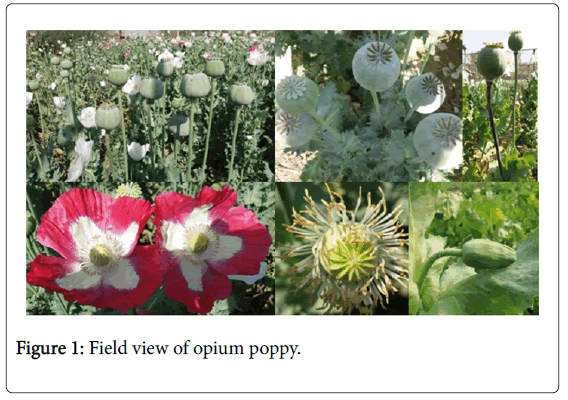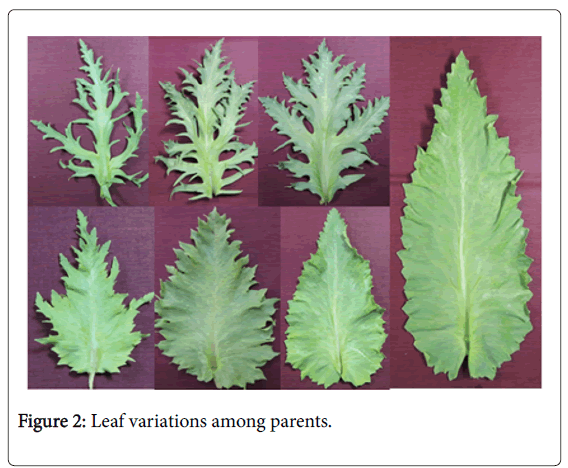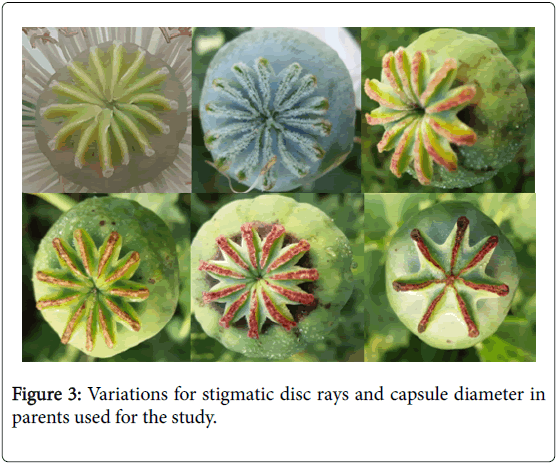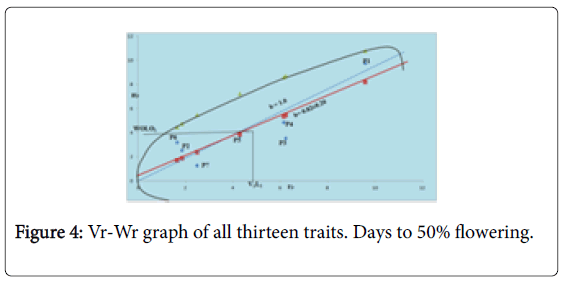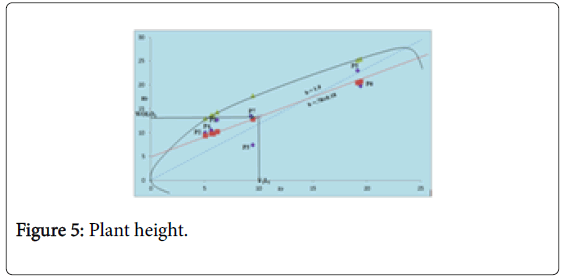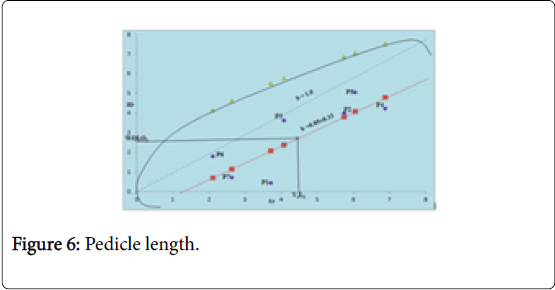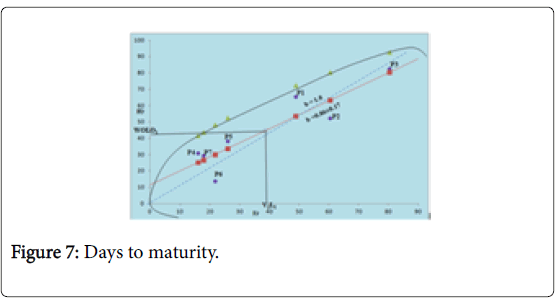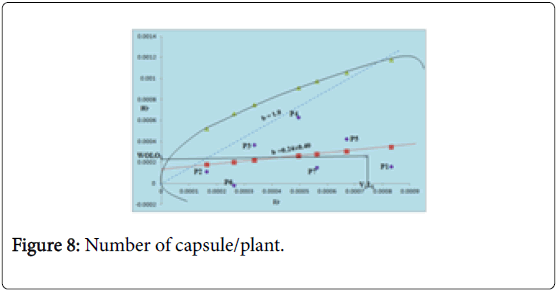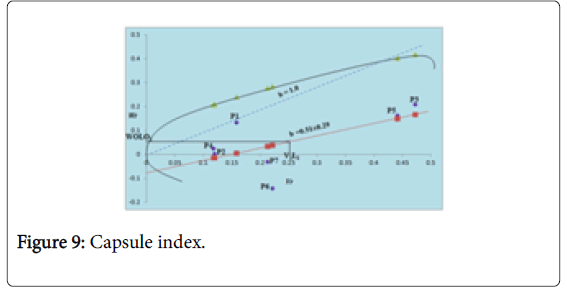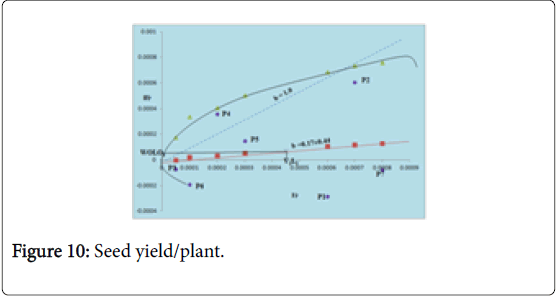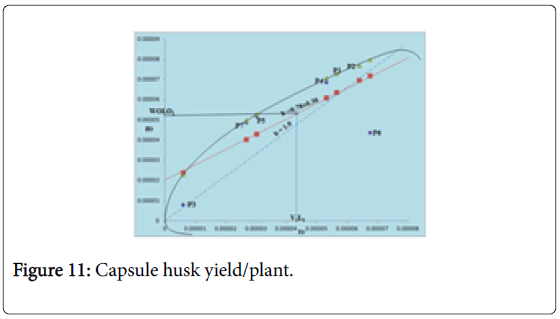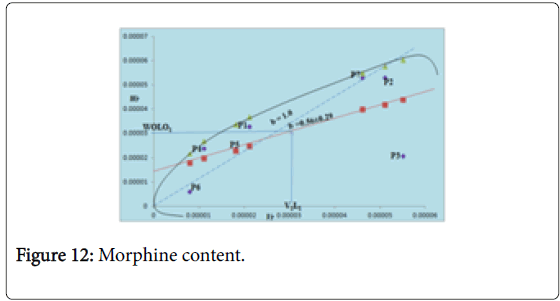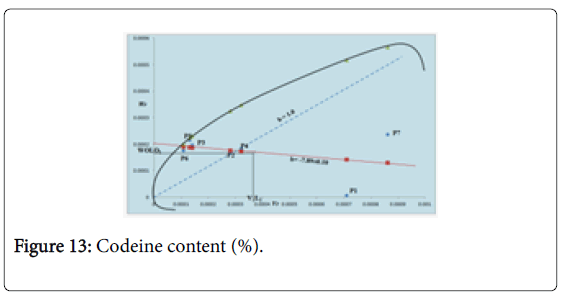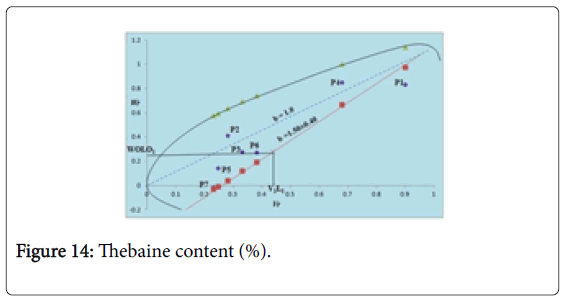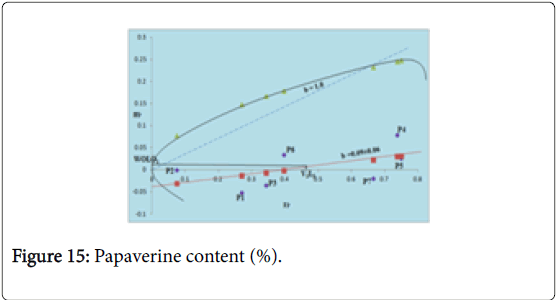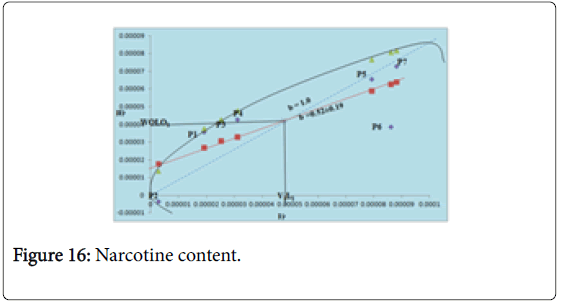Estimation of Components of Genetic Variation and Graphical Analysis in Opium Poppy (Papaver somniferum L.)
Received: 02-Apr-2019 / Accepted Date: 18-Apr-2019 / Published Date: 27-Apr-2019 DOI: 10.4172/2329-8863.1000424
Abstract
Opium poppy (Papaver somniferum L.) is an important medicinal plant known for its high valuable alkaloids and poppy seed. The genetics and inheritance pattern of some important characters, like days to 50% flowering, plant height, days to maturity, number of capsule per plant, capsule index, capsule husk yield, seed yield per plant, morphine, codeine, thebaine, papaverine and narcotine content were measured by diallel analysis of first generation progenies from seven parents. There is almost all character for which additive component of genetic variance was significant except number of capsule and codeine content. On the other hand, the dominance component of genetic variance was found significant for all the characters except thebaine and codeine content. Narrow sense heritability was high for plant height, papaverine content and days to maturity. While the degree of genetic advance was high only for capsule index and days to maturity. The validity of hypothesis of additive-dominance model was tested by confirming unit slope of regressions of Wr and Vr and by non-significant value of t2. We concludes that isolation of superior genotypes by sib selection and recurrent selection, and exploitation of hybrid vigor in specific parental-cross combinations are good strategies for poppy crop improvement.
Keywords: Crop improvement; Diallel analysis; Genetic advance; Heterozygosity; Over-dominance
Introduction
Papaver somniferum L. is one of the very important species which has been used since the Neolithic. Opium poppy is valued for its alkaloids and seed. It is the most economic narcotic plant species among genus Papaver . The cultivation of opium poppy permitted by special legislation in the world [1]. Its worldwide distribution results from its long history in cultivation. The opium poppy plant contains different narcotic alkaloids such as morphine, codeine, thebaine, noscapine and papaverine, and they are also used for the production of semi-synthetic active pharmaceuticals [2] morphine and codeine. These alkaloids are also used as an antispasmodic drug for treatment of different type intestinal and urinary tract spasms, migraine headaches, bronchial asthma, pulmonary arterial embolism and schizophrenia [3-8] and occasionally used to treat erectile disorders [9-12]. Poppy seeds from the opium poppy are used for food by edible oil, cosmetic, and the paint industries [13]. The seeds of poppy do not contain the opium alkaloids, but sometimes can become contaminated with alkaloids as a result of pest damage and during harvesting. The different alkaloids like morphine, codeine, thebaine, papaverine and narcotine of opium poppy are used as an important raw material by different industries of pharmacy to make cough suppressant, painkillers and spasm reduction drugs [14-17]. The cultivation of poppy mostly occurs in countries such as India, Japan, China, France, and Spain. Most poppy cultivation takes place in Turkey and India. The poppy is cultivated in an area of 101874 hectares in the world [18], and it is cultivated on an area of 61591 hectares, with an annual production of 30730 tons and an average yield of 500 kg ha-1 in Turkey [19]. Since, opium poppy is a very important crop nationally/internationally, therefore, the study of the nature and amount of genetic variability will be the first breeding objective for any plant breeder. Therefore, our purpose of endeavor and objective of study are:
• To workout nature and amount of variability in the accessions of opium poppy.
• Study of genetics and inheritance pattern of important economic traits by diallel mating design followed by graphical analysis.
Materials and Methods
The field experiment was set up in a randomized complete block design in 2015/16 and 2016/17. All the 49 treatments were grown in Randomized Block Design with three replications at CSIR-Central Institute of Medicinal and Aromatic Plants. The experimental material comprised 49 genotypes, including 21 F1s plants, 21 reciprocals and 7 parents (Table 1). All Parents were homozygous as they were selfpollinated for few generations and selected on the basis of morphological metric traits and these are numbered P1 to P7. The data was recorded for different traits viz., days to 50% flowering, plant height, days to maturity, number of capsules per plant, capsule index, capsule husk yield, seed yield per plant, morphine, codeine, thebaine, papaverine and narcotine content. The material under present investigation was tested for the agreement with basic assumptions to Hayman diallel analysis [20].
| S No | Parent No. | Name | Salient features |
|---|---|---|---|
| 1 | A-47 | Shweta | Tall with broad leaves, white smooth petal flower, yellow pedicle color, very bold big capsule, High yielding variety. |
| 2 | A-32 | SPS- 20 | Tall with deeply fringed leaf, white smooth flower, yellow pedicle with downy mildew tolerant. |
| 3 | A-2 | CIMAP Ajay | Medium tall plant with very deeply fringed small leaf, white medium fringed flower, yellow pedicle |
| 4 | A-75 | Sampada | Medium tall variety with medium fringed leaves, black pedicle and white smooth petals flowers, medium size capsules |
| 5 | A-73 | Shyama | Medium tall, broad leaves, white smooth petal flower, black pedicle |
| 6 | A-6 | N-3 | Medium tall medium fringed leaves, bold capsule, yellow pedicle, white medium fringed petal margin in flower, Downy mildew resistance |
| 7 | A-74 | Sanchita | Tall, medium broad leaf, white smooth petal flower, yellow pedicle, High yielding variety |
Table 1: Salient feature of seven diverse parents selected for 7 × 7diallel in opium poppy.
Chemical analysis
For chemical analysis the dry powder of capsule husk (1 g) was first dissolved in methanol and sonicated for 30 min in an ultrasonic bath, and the solution was then centrifuged at 10,000 rpm for 10 min and then samples were then taken for HPTLC analysis. Each standard were separately weighed and stock solution prepared. From each standard stock solution equal volume has taken and mixed to prepare working standard. TLC-densitometric procedure was used to analyze the five major opium alkaloids morphine, codeine, thebaine, papaverine and narcotine [21]. Toluene-acetone-methanol-ammonia (40:40:6:2) was used as a mobile phase. Silica gel plates 60 F254 were scanned after derivatization using Dragendorff reagent no. llC used to detect alkaloid [22] at 540 nm.
Statistical analysis
Statistical analyses was done using the Statistical Software 4.0 version, available in the Division of Genetics and Plant Breeding of the CSIR-Central Institute of Medicinal and Aromatic Plants, Lucknow, India, that is based on the standard methods in Panse and Sukhatme (1967) and Singh and Chaudhary (1979). The pooled mean values of two years for the all thirteen characters were subjected to Hayman diallel analysis (Figures 1-3) [20].
Estimation of components of variation (Griffing’s model and Hayman’s model)
Analysis of genetic variance components was carried out by numerical analysis as per Hayman's [20] model. The following statistics were computed.
D̂=VOLO-E (variation due to additive gene effect)
F̂=2VOLO-4WVOLO1-2(n-2) E/n (The mean of ‘Fr’ over the arrays)
Ĥ1=VOLO-4WOLO1+4V1L1-(3n-2) E/n (Component of variation due to dominance effects of genes)
Ĥ2=4V1L1-4VOL1-2E=H1[1-(u-v)2] (Proportion of positive and negative genes in parents where, u was the proportion of positive genes and v was the proportion of negative genes and u+v=1)
ĥ2=4(ML1-MLO)2-4(n-1)E/n2 (Dominance effect as the algebraic sum over all loci in heterozygous phase in all crosses)
To test each of these components standard error for each was also calculated. For this first of all common multiplier or variance (=s2) was calculated as per following formula:
s2=(1/2)[Var (Wr-Vr)]
s2=(1/2)[1/n-1{[Ʃ(Wri-Vri)]2-[Ʃ(Wri-Vri)]2/n}]
Now from Hayman ׳s [20] the specific multiplier for each component was calculated, considering n=7, these are for:
D=(n5+n4)/n5
F=(4n5+20n4-16n3+16n2)/n5
H1=(n5+41n4-12n3+4n2)/n5
H2=(36n4)/n5
h2=(16n4+16n2-32n+16)/n5
H1=n4/n5
Graphical analysis (Wr-Vr graphs)
The validity of the assumptions of diallel theory was tested by 't2' test [20,23] for uniformity of Vr, Wr values.

The graphical analysis was done according to Hayman [23]. The Vr, Wr points for the parental were depicted along the Vr, Wr axes. Vris the variance of rth array and Wr is the covariance between the parent and the offspring in the rth array. The relationship between Vr and Wr provides some useful information as follows:
• When the regression line passes through the origin, it indicates complete dominance (D=H1).
• When it passes above the origin, cutting the Wr axis, it suggests the existence of partial dominance (D>H1).
• When it passes above the origin, cutting the Wr axis and touching the limiting parabola, it suggests the absence of dominance.
• But when it passes below the origin, cutting the Vr axis, it denotes the presence of over dominance.
• The position of parental points on the regression line indicates the dominance order of the parents. The parents with more dominant gene are located nearer to the origin, while those with more recessive genes fall farther from the origin. The parents with equal frequencies of dominant and recessive genes occupy an intermediate position.
Results and Discussion
Graphical analysis was done of the experimental data to get the information about allelic constitution of the parents used in the diallel cross. The validity of hypothesis of additive-dominance model was tested by confirming unit slope of regressions of Wr and Vr and by non-significant value of t2 as prescribed by Hayman [23]. In this experimental study, regression coefficient values (b, wr, vr) for thirteen characters viz., days to 50% flowering, plant height, days to maturity number of capsule per plant, capsule index, capsule husk yield, seed yield per plant, morphine, codeine, thebaine, papaverine and narcotine did not differ significantly from unity indicating the absence of epistasis. This indicated the fulfilment of the assumption that epistasis is absent for these characters.
The Wr-Vr graphs for all the thirteen traits have been presented in Figures 4-16. The parental array points were scattered all along the regression line for almost all the thirteen traits. This represents the genetic diversity among all the seven parents for all the character studied [24,25]. The relative proportion of recessive and dominant alleles present in parent was represented by the distribution of array points.
The regression line passed through the Wr-axis above the origin indicating partial dominance for this trait like days to 50% flowering, plant height, days to maturity, capsule index, morphine, thebaine, codeine, papaverine and narcotine content. While for characters like pedicle length, number of capsules per plant, seed yield, capsule husk yield and morphine content the regression line cut the Wr-axis just below the origin pointed out over dominance effect. The scattered array point on the regression indicates diversity among parents.
The additive and non-additive genetic variances were estimated with the help of diallel Griffing’s model, [26] and Hayman’s model [20,23] for all thirteen traits in the opium poppy are presented in Tables 2 and 3, respectively. By using Griffing’s model [26], it is depicted from the observations that the non-additive variance  was higher than the additive genetic
was higher than the additive genetic  variance for all the traits except for plant height, days to maturity and thebaine content and narcotine content in percent.
variance for all the traits except for plant height, days to maturity and thebaine content and narcotine content in percent.
| Variance components | DF | PH | PL | DM | NC | CI | SY | CHY | M | C | T | P | N |
|---|---|---|---|---|---|---|---|---|---|---|---|---|---|
| σ̂g2 | 2.03 | 5.71 | 0.87 | 19.3 | -0.03 | 0.00002 | 0.009 | 0.026 | -0.0000008 | 0.00005 | 0.000029 | 0.000014 | 0.000023 |
| σ̂s2=σ̂D2 | 2.21 | 4.17 | 3.41 | 17.38 | 0.15 | 0.0002 | 0.1886 | 0.365 | 0.000451 | 0.00031 | 0.000013 | 0.000015 | 0.000024 |
| σ̂r2 | 1.19 | 8.26 | 3.8 | 10.11 | 0.03 | 0.0002 | 0.2328 | 0.218 | 0.000130 | 0.00024 | 0.000002 | 0.000017 | 0.000034 |
| σ̂e2 | 0.6 | 0.27 | 0.26 | 3.56 | 0.081 | 0.0003 | 0.0886 | 0.083 | 0.0000016 | 0.000001 | 0.0000003 | 0.0000009 | 0.00000014 |
| σ̂A2 | 1.07 | 11.4 | 1.74 | 38.6 | -7.76 | 0.00005 | 0.018 | 0.052 | -0.0000017 | 0.0001 | 0.000059 | 0.000028 | 0.000018 |
| σ̂g2/σ̂s2 | 0.91 | 1.36 | 0.25 | 1.11 | -0.2 | 0.1 | 0.047 | 0.071 | -0.00177 | 0.161 | 2.2307 | 0.93333 | 1.0434 |
| √(σ̂s2/σ̂g2) | 1.043 | 0.854 | 1.979 | 0.948 | -2.236 | 3.162 | 4.577 | 3.746 | -23.743 | 2.489 | 0.6695 | 1.035 | 0.978 |
| σ̂g2=g.c.a. variance, σ̂s2=σ̂D2=s.c.a. variance, σ̂r2=reciprocal variance, σ̂e2=environmental variance, *=p<0.05; **=p<0.01, DF=Days to 50% flowering, PH=Plant height (cm), PL=Pedicle length (cm), DM=days to maturity, NC=Number of capsule/plant, CI=Capsule index, SY=Seed yield/plant (g), CHY=Capsule husk yield/plant, M=Morphine content (%), C=Codeine content (%), T=Thebaine content (%), P=Papaverine content (%), N=Narcotine content(%),respectively. | |||||||||||||
Table 2: Estimates of variance components and allied genetic parameters for different traits in poppy.
The ratio of  /
/ which is less than unity clearly expressed that non fixable components were predominant over fixable component. For plant height, days to maturity, thebaine content and narcotine content is greater than unity which clearly indicating that fixable components was predominant over non-fixable component. The additive variance (
which is less than unity clearly expressed that non fixable components were predominant over fixable component. For plant height, days to maturity, thebaine content and narcotine content is greater than unity which clearly indicating that fixable components was predominant over non-fixable component. The additive variance (  /
/ ) was larger than the environmental variance (
) was larger than the environmental variance ( ) for characters namely plant height, days to 50% flowering, pedicle length, days to maturity codeine content, thebaine content, papaverine content and narcotine content in percent. Hence, favorable or unfavorable environments did not influence the predominance of nonfixable genetic variance. The trait namely number of capsule/plant, capsule index, seed yield, capsule husk yield and morphine content (%) influenced by environmental factors as the environmental variance (
) for characters namely plant height, days to 50% flowering, pedicle length, days to maturity codeine content, thebaine content, papaverine content and narcotine content in percent. Hence, favorable or unfavorable environments did not influence the predominance of nonfixable genetic variance. The trait namely number of capsule/plant, capsule index, seed yield, capsule husk yield and morphine content (%) influenced by environmental factors as the environmental variance ( ) was higher than the additive variance (
) was higher than the additive variance ( ) (Table 2).
) (Table 2).
The uniformity of Wr, Vr indicates the validity of assumptions made by the Hayman [20]. The t2 values were calculated which was found insignificant for all the characters except number of capsule/plant and codeine content. The insignificant t2 values indicated absence of epistasis for all characters except number of capsule/plant and codeine content suggesting the fulfillment of diallel analysis.
Nevertheless, by use of Hayman’s model, the additive component of variance (D̂) was found highly significant for all the characters except number of capsules/plant and codeine content in percent whereas, dominance component (Ĥ1) of genetic variance was significant for all the characters except codeine and thebaine content in (%), exhibiting that the expression of all these characters was controlled by both additive and dominance gene. The overall dominance effect was determined by ĥ2 estimating sum total over all the loci in heterozygous state which was found positive and significant for days to 50% flowering. While the insignificant ĥ2 estimates were observed for plant height, pedicle length, days to maturity, number of capsules, seed yield, capsule husk yield, morphine, thebaine, papaverine and narcotine content. However, insignificant and negative ĥ2 estimates were recorded for capsule index. This suggests that substantial amount of heterozygosity in the parents was present showing significant ĥ2 estimates and was insignificant for others. The estimates of Ĥ1 were also higher than estimates of ĥ2 for all the traits (Table 3). The estimates for F̂ component were positive and significant for days to 50% flowering, plant height, pedicle length, capsule index, and capsule husk yield suggesting excess of positive gene controlling these characters. The estimates for F̂ component were negative and insignificant for thebaine and narcotine content respectively
| Variance components | DF | PH | PL | DM | NC | CI | SY | CHY | M | C | T | P | N |
|---|---|---|---|---|---|---|---|---|---|---|---|---|---|
| D̂ (Additive component) | 11.513** ± 1.069 | 33.085** ± 2.271 | 8.033** ± 1.037 | 103.81** ± 7.946 | 0.0001 ± 0.180 | 0.001** ± 0.0002 | 0.276** ± 0.0914 | 1.361** ± 0.201 | 0.00069* ± 0.00031 | 0.00037 ± 0.00025 | 0.000094** ± 0.000012 | 0.000065** ± 0.000012 | 0.000075** ± 0.000017 |
| Ê (Environmental component) | 0.614 ± 0.378 | 0.274 ± 0.803 | 0.278 ± 0.366 | 3.541 ± 2.809 | 0.081 ± 0.06 | 0.00038** ± 0.00007 | 0.0929** ± 0.0323 | 0.0831 ± 0.0711 | 0.0000017 ± 0.00011 | 0.0000013 ± 0.000089 | 0.00000033 ± 0.0000043 | 0.000001 ± 0.000004 | 0.00000014 ± 0.0000062 |
| F (Mean cov. of D) | 6.946** ± 2.565 | 12.895* ± 5.449 | 5.310** ± 2.488 | 30.114 ± 19.064 | 0.027 ± 0.433 | 0.0017** ± 0.0005 | 0.394 ± 0.219 | 1.640** ± 0.482 | 0.00109 ± 0.000746 | 0.000062 ± 0.00060 | -0.000024 ± 0.000029 | 0.0000081 ± 0.000028 | -0.000019 ± 0.000042 |
| Ĥ1 (Dominance component) | 12.404** ± 2.574 | 19.388** ± 5.469 | 14.414** ± 2.496 | 73.093** ± 19.131 | 1.688** ± 0.435 | 0.0014** ± 0.0005 | 0.898** ± 0.220 | 1.843** ± 0.484 | 0.0022** ± 0.00074 | 0.0011 ± 0.00060 | 0.000053 ± 0.000029 | 0.000061* ± 0.000029 | 0.000095* ± 0.000042 |
| Ĥ2 (Proportion of +/- genes) | 7.740** ± 2.268 | 14.671** ± 4.819 | 11.970** ± 2.200 | 61.084** ± 16.857 | 1.593** ± 0.383 | 0.00079 ± 0.00044 | 0.653** ± 0.194 | 1.281** ± 0.426 | 0.0015* ± 0.00066 | 0.0011* ± 0.00053 | 0.000046 ± 0.000026 | 0.000055* ± 0.000025 | 0.000082* ± 0.000037 |
| ĥ2 (Overall dominance effect) | 6.153** ± 1.523 | 2.553 ± 3.236 | 0.983 ± 1.477 | 0.346 ± 11.322 | 0.289 ± 0.257 | -0.00008 ± 0.00029 | 0.0105 ± 0.130 | 0.352 ± 0.286 | 0.000021 ± 0.00044 | 0.00016 ± 0.00035 | 0.0000049 ± 0.000017 | 0.0000002 ± 0.000017 | 0.0000070 ± 0.000025 |
| *=p<0.05; **=p<0.01; DF=Days to 50% flowering, PH=Plant height (cm), PL=Pedicle length (cm), DM=days to maturity, NC=Number of capsule/plant, CI=Capsule index, SY=Seed yield/plant (g), CHY=Capsule husk yield/plant, M=Morphine content (%), C=Codeine content (%), T=Thebaine content (%), P=Papaverine content (%), N=Narcotine content (%), respectively. | |||||||||||||
Table 3: Estimates of genetic components of variance in 7 × 7 diallel crosses for thirteen characters in opium poppy.
Other allied parameters were also calculated for all thirteen characters on the basis of Hayman’s model presented in Table 4. It was found that estimates of dominance were higher than unity for Days to 50% flowering, pedicle length, no of capsule/plant, capsule index, seed yield/plant, capsule husk yield, morphine, codeine and narcotine content suggesting over dominance while, plant height, days to maturity, thebaine and papaverine content was less than unity showing partial dominance.
| Proportion | DF | PH | PL | DM | NC | CI | SY | CHY | M | C | T | P | N |
|---|---|---|---|---|---|---|---|---|---|---|---|---|---|
| (H1/D)1/2 | 1.038 | 0.765 | 1.339 | 0.839 | 100.84 | 1.067 | 1.804 | 1.163 | 1.79 | 1.767 | 0.75 | 0.973 | 1.123 |
| (H2/4H1) | 0.156 | 0.189 | 0.207 | 0.208 | 0.235 | 0.132 | 0.181 | 0.173 | 0.179 | 0.237 | 0.216 | 0.222 | 0.216 |
| {1/4(4DH1)1/2+(1/2)F}/{1/4(4DH1)1/2-(1/2)F } | 1.819 | 1.683 | 1.655 | 1.417 | 10.84 | 4.552 | 2.309 | 3.147 | 2.602 | 1.099 | 0.705 | 1.137 | 0.792 |
| Coor(r)=(Wr+Vr).Yr | 0.9142 | -0.497 | -0.097 | -0.845 | 0.025 | -0.0322 | 0.324 | 0.849 | 0.405 | -0.34 | 0.172 | 0.0079 | 0.383 |
| r2 | 0.8359 | 0.247 | 0.0095 | 0.714 | 0.00066 | 0.00104 | 0.105 | 0.721 | 0.164 | 0.116 | 0.0299 | 0.000062 | 0.146 |
| ph2/H2 | 0.794 | 0.174 | 0.0821 | 0.0056 | 0.181 | 0.106 | 0.016 | 0.275 | 0.0135 | 0.145 | 0.106 | 0.0039 | 0.085 |
| ƩFri | 48.627 | 90.268 | 37.174 | 210.79 | 0.194 | 0.0124 | 2.758 | 11.486 | 0.0076 | 0.00043 | 0.000171 | 0.000057 | 0.0001 |
| t2 | 0.0898 | 0.317 | 0.1914 | 0.0701 | 55.519 | 0.0192 | 0.274 | 6.602 | 0.0000087 | 19.548 | 0.017 | 0.173 | 1.794 |
| ĥ2 (ns)% | 64.41% | 75.90% | 44.12% | 69.40% | 6.53% | 15.80% | 19.80% | 25.90% | 21.%4 | 39.80% | 84.10% | 68.30% | 72.10% |
| GA over mean | 3.75 | 3.003 | 4.449 | 20.05 | 4.009 | 64.76 | 11.72 | 3.96 | 0.1071 | 0.0177 | 0.0192 | 0.0025 | 0.389 |
| Here, DF=Days to 50% flowering, PH=Plant height (cm), PL=Pedicle length (cm), DM=days to maturity, NC=Number of capsule/plant, CI=Capsule index, SY=Seed yield/plant (g), CHY=Capsule husk yield/plant, M=Morphine content (%), C=Codeine content (%), T=Thebaine content(%), P=Papaverine content (%), N=Narcotine content (%), respectively | |||||||||||||
Table 4: Proportion of the genetic component of variance in 7 × 7 diallel crosses for thirteen characters in opium poppy.
The proportion of genes with positive and negative effect was determined with the help of two parameters Ĥ2/4Ĥ1 and Coor(r)=(Wr+vr)Yr. The former statistic determines the symmetry or asymmetry of distribution, the later explain the simple proportion of genes showing positive and negative effects. By comparing (Wri+Vri) with Yri we can estimate the direction of dominance. If the correlation is negative, it shows parents containing most increasing genes have the lowest value of (Wri+Vri and thus contain most dominant genes and correlation will be positive if the case is reverse. The estimates of the ratio Ĥ2/4Ĥ1 were close to expected value of 0.25 for no of capsule and codeine content suggesting symmetrical distribution of positive and negative dominant genes in parents. For days to 50% flowering, plant height, pedicle length, capsule index, seed yield, capsule husk yield, thebaine, papaveine and narcotine content was far from the expected value reveling an asymmetrical distribution of positive and negative genes among the parents.

Which gives the relative value of dominant and recessive genes, was found greater than unity for all the characters except two alkaloid characters i.e., thebaine and narcotine content. The measurement of completely dominant or recessive parents may not be predicted with con idence for any of the traits, as the r2 values were considerably less than 1. The Set of genes which control the character and exhibit dominance was determined by ĥ2/Ĥ2 which was less than unity for all the characters. The ratio ĥ2/Ĥ2 denotes an appropriate number of genes or group of genes controlling the characters, exhibiting dominance.
Narrow sense heritability ĥ2 (ns) ranged from 6.53% (lowest) for number of capsule/plant to 84.1% (highest) for thebaine content. It was high for plant height (75.9%), narcotine content (72.1%), days to maturity (69.4%), papaverine content (68.3%), and days to flowering (64.41%) in order. Other characters pedicle length (44.12%), codeine content (39.8%), capsule husk yield (25.9%) and morphine (21.4%) were moderately heritable. The rest three traits, namely, seed yield (19.8%), capsule index (15.8%) and capsule number/plant (6.53%) were expressed low heritability in narrow since in percent (Table 4). Our results are also in agreement with many research workers [24,27-30].
The genetic advance provides information regarding degree of genetic gain obtained in a selected trait under a particular selection pressure. It is basically a function of selection intensity, heritability and phenotypic variance. Thus, it provides information over heritability and helps breeders in selection programme. Genetic advance over mean ranged from 64.76% (capsule index) which is highest and to 0.0025% (papaverine content) which is the lowest value. It was high for capsule index (64.76%) followed by days to maturity (20.05%) and seed yield (11.72%), respectively. Medium genetic advance over mean were found for pedicle length (4.449%), number of capsule (4.009%), capsule husk yield (3.96%), days to 50% flowering (3.75%), plant height (3.003%). Low genetic advance over mean was recorded for narcotine (0.389%), morphine content (0.1071%), thebaine (0.0192%), codeine (0.0177%), and papaverine content (0.0025%), respectively.
Conclusion
The additive component (D̂) of genetic variance was found highly significant for all the characters except number of capsules/plant and codeine content in percent whereas, dominance component (Ĥ1) of genetic variance was significant for all the characters except codeine and thebaine content. The estimation of narrow sense heritability is a very useful selection parameter in plant breeding. It is found high for number of capsule/plant, thebaine content, plant height, narcotine content, days to maturity, papaverine content and days to flowering, However, genetic advance was high for capsule index and days to maturity. Based on this genetic information in this study, hybridizations, isolation of superior genotypes by sib selection and recurrent selection, and exploitation of hybrid vigor in specific parent cross-combinations are suggested for poppy crop improvement.
Acknowledgment
Authors thanks to the Director, CSIR-CIMAP, Lucknow for the encouragement and facilities provided during the investigation. Author thanks CSIR- New Delhi, for providing Senior Research Fellowship.
References
- Kapoor L (1995)Opium poppy: Botany, chemistry, and pharmacology. CRC Press.
- Skalicky M, Hejnak V, Novak J, Hejtmankova A, Stranska I (2014) Evaluation of selected poppy (Papaver somniferum L.) cultivars: Industrial aspect.Turkish Journal of Field Crops19: 189-196.
- Brisman JL, Eskridge JM, Newell DW (2006) Neuro-interventional treatment of vasospasm.Neurological Research28: 769-776.
- Damen L, Bruijn J, Verhagen AP, Berger MY, Passchier J, et al. (2006) Prophylactic treatment of migraine in children. Part 2. A systematic review of pharmacological trials.Cephalalgia26: 497-505.
- Mindea SA, Yang BP, Bendok BR, Miller JW, Batjer HH (2006) Endovascular treatment strategies for cerebral vasospasm.Neurosurgical Focus21: 1-7.
- Menniti FS, Chappie TA, Humphrey JM, Schmidt CJ (2007) Phos-phoesterase 10A inhibitors: A novel approach to the treatment of the symptoms of schizophrenia. Curr Opin Investig Drugs 8: 54–59.
- McGeoch RJ, Oldroyd KG (2008) Pharmacological options for inducing maximal hyperaemia during studies of coronary physiology.Catheterization and Cardiovascular Interventions71: 198-204.
- Srivastava VK, Agrawal S, Sahu S (2011) Association of acute onset hypertension and tachycardia following intracisternal papaverine administration during intracranial aneurysm surgery: A case report and review of the literature.J Clin Anesth 23: 224-226.
- Bella AJ, Brock GB (2004) Intracavernous pharmacotherapy for erectile dysfunction.Endocrine23: 149-155.
- Desvaux P (2005) An overview of the management of erectile disorders.Presse Medicale34: 5-7.
- Barry JM (2007) Treating erectile dysfunction in renal transplant recipients.Drugs67: 975-983.
- Priebe HJ (2007) Aneurysmal subarachnoid haemorrhage and the anaesthetist.Br J Anaesth 99: 102-118.
- Gümüşçü A, Arslan N (2008) Researches on heterosis on yield and yield components of some poppy hybrid (Papaver somniferum L.) lines.J Agric Sci (Turkey) 2: 1.
- Gümüs CUA (2002) Researches on heterosis on yield and some traits of the hybrids of selected poppy (Papaver Somniferum L.) lines. PhD, Ankara University, Ankara, Turkey.
- Németh-Zámbori É, Jászberényi C, Rajhárt P, Bernáth J (2011) Evaluation of alkaloid profiles in hybrid generations of different poppy (Papaver somniferum L.) genotypes.Industrial Crops and Products33: 690-696.
- Anon A (2013) Poppy report. soil crops office (Toprak Mahsullar Ofisi).
- FAO (2015) Food and agriculture organization of the United Nations-2015.
- Hayman BI (1954) The analysis of variance of diallel tables.Biometrics10: 235-244.
- Gupta MM, Verma RK (1996) Combined thin-layer chromatography-densitometry method for the quantitative estimation of major alkaloids in poppy straw samples.Indian J Pharm Sci58: 161.
- Wagner H, Bladt S (1996)Plant drug analysis: A thin layer chromatography atlas. Springer Science and Business Media.
- Hayman BI (1954) The theory and analysis of diallel crosses. Genetics 39: 789- 809.
- Shukla S, Raj K, Shanker K, Singh S (2018) Evolutionary pattern on genetic resources and diversity in Indian land races of Opium Poppy (Papaver somniferum L.). Acta Scientific Agriculture 2: 116-122.
- Georgieva N, Nikolova I, Naydenova Y (2018) Possibility for weed control by using of an organic product with herbicidal effect.Banat's Journal of Biotechnology9: 40-49.
- Griffing B (1956) A generalised treatment of the use of diallel crosses in quantitative inheritance.Heredity10: 31.
- Lahiri R, Lal RK, Sarkar S, Kumar D, Dubey BK, et al. (2017) Genetics of alkaloids in poppy straw with other morphological traits in opium poppy (Papaver somniferum L.).Journal of Applied Research on Medicinal and Aromatic Plants7: 74-83.
- Lahiri R, Lal RK, Srivastava N, Shanker K (2018) Genetic variability and diversity in Indian germplasm of opium poppy (Papaver somniferum L.).Journal of Applied Research on Medicinal and Aromatic Plants8: 41-46.
- Gupta V (2018) Smart materials in dentistry: A review.International Journal of Advance Research and Development3: 89-96.
- Karabük B (2012) The effects of nitrogen fertilization and sowing methods on agricultural and quality of poppy (Papaver somniferum L.) varieties.Ondokuz Mayıs Uni Inst of Nat and Appl Sci 2: 1.
Citation: Shukla S, Lal RK, Singh VR, Shanker K (2019) Estimation of Components of Genetic Variation and Graphical Analysis in Opium Poppy (Papaver somniferum L.). Adv Crop Sci Tech 7: 442. DOI: 10.4172/2329-8863.1000424
Copyright: © 2019 Shukla S, et al. This is an open-access article distributed under the terms of the Creative Commons Attribution License, which permits unrestricted use, distribution, and reproduction in any medium, provided the original author and source are credited.
Select your language of interest to view the total content in your interested language
Share This Article
Recommended Journals
Open Access Journals
Article Tools
Article Usage
- Total views: 5626
- [From(publication date): 0-2019 - Dec 17, 2025]
- Breakdown by view type
- HTML page views: 4608
- PDF downloads: 1018

